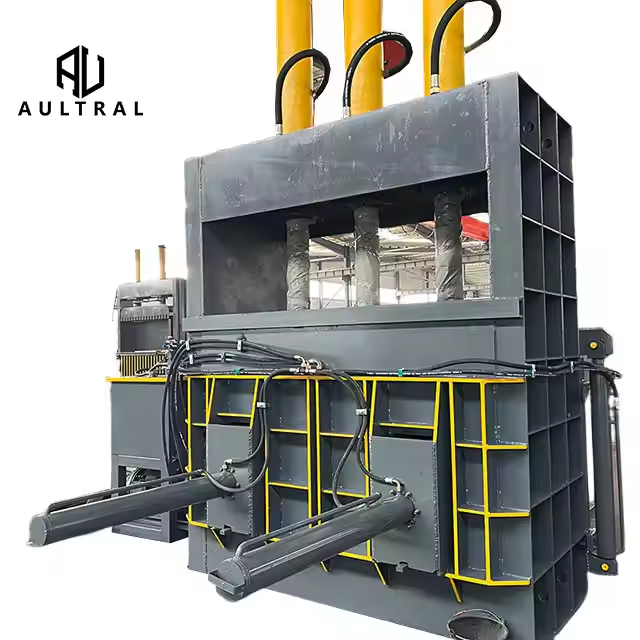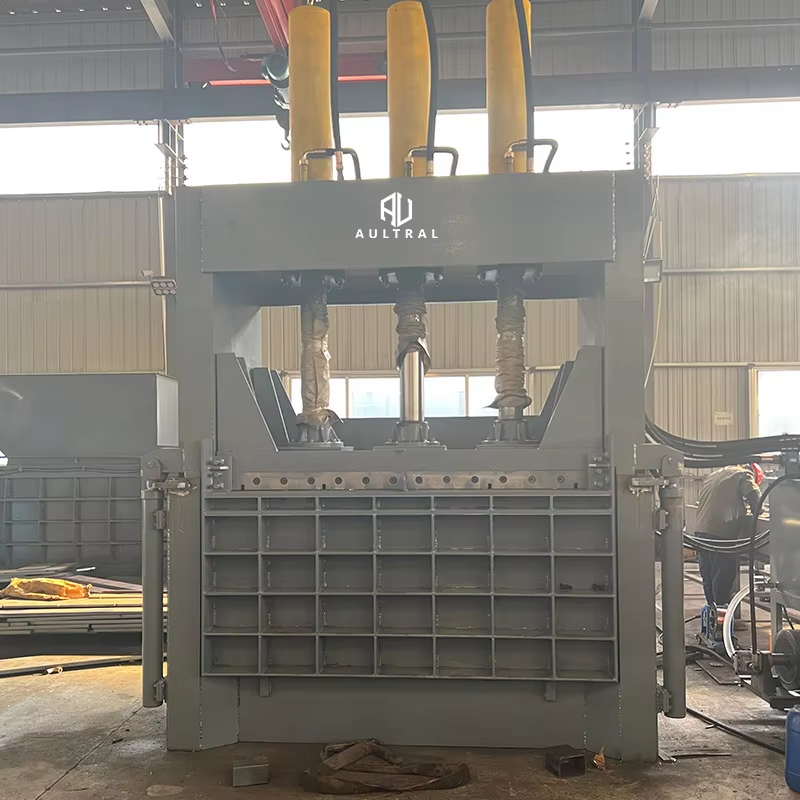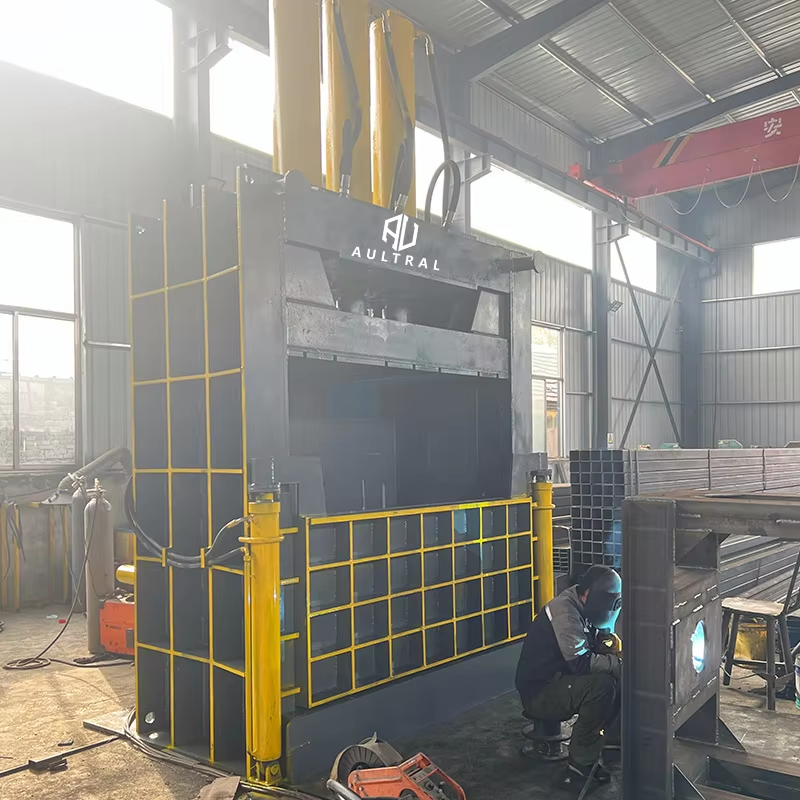What is a Vertical Metal Baler?

A vertical metal baler is a powerful industrial machine used to compress scrap metal into compact, dense bales for easier handling, storage, and transportation. Unlike horizontal balers that compress materials sideways, vertical balers use a top-down hydraulic pressing system, making them ideal for operations where floor space is limited. These machines are commonly found in scrap yards, recycling centers, manufacturing plants, and metal processing facilities.
The working process of a vertical metal baler is simple yet highly effective. First, loose scrap metal—such as aluminum cans, steel sheets, copper wire, or automotive parts—is loaded into the machine’s chamber. A hydraulic ram then presses downward with tremendous force, compacting the metal into a tightly packed block. Once fully compressed, the bale is typically secured with steel straps or wires to maintain its shape before being ejected for storage or shipment.
One of the biggest advantages of vertical balers is their space-saving design. Since they operate vertically, they require less floor space than horizontal balers while still delivering strong compression force. This makes them a popular choice for smaller facilities or businesses looking to maximize workspace efficiency. Additionally, vertical balers help reduce transportation costs by creating dense, uniform bales that take up less room during shipping. They also improve workplace safety by minimizing the need for manual handling of sharp or heavy metal scraps.
Vertical balers are versatile and can process various types of metal waste, from thin aluminum cans to thicker steel materials. While they may not produce the massive bales that horizontal balers do, their compact size, efficiency, and lower operational costs make them an excellent choice for small to mid-sized recycling operations. Whether for scrap metal dealers, auto recyclers, or industrial manufacturers, vertical metal balers provide a cost-effective and practical solution for managing metal waste and turning it into a valuable, recyclable commodity.
Why use the Vertical Metal Baler?

The vertical metal baler offers several key advantages that make it a preferred choice for scrap metal processing. Its space-saving vertical design is ideal for facilities with limited floor space, as it requires a smaller footprint than horizontal balers while still delivering powerful compression. This efficient machine transforms loose scrap metal – from aluminum cans to steel sheets – into dense, uniform bales that are easier to handle, store, and transport.
By compacting scrap into tight bales, businesses can significantly reduce transportation costs and maximize storage capacity. The automated pressing system minimizes manual handling of sharp or heavy metals, improving workplace safety. Vertical balers are particularly valuable for small to medium-sized operations, offering an affordable yet highly effective solution for metal recycling. Their versatility allows processing of various metal types, making them a practical investment for scrap yards, manufacturing plants, and recycling centers looking to optimize their operations and increase profitability.
How to use the Vertical Metal Baler?

Operating a vertical metal baler is a straightforward process that can significantly improve your scrap metal handling efficiency. This powerful machine transforms loose metal waste into compact, manageable bales through a series of carefully controlled steps. Whether you’re processing aluminum cans, steel sheets, or copper wire, following proper procedures ensures optimal performance and safety.
Preparation Stage
Before starting the baler, conduct a thorough inspection of the equipment. Check hydraulic fluid levels, examine all safety mechanisms, and ensure the compression chamber is clear of any obstructions. Verify that emergency stop buttons function properly and that all guards are in place. Wear appropriate personal protective equipment (PPE) including gloves, safety glasses, and steel-toe boots. Position the scrap metal near the loading area for convenient access, sorting out any non-metallic materials that could damage the machine.
Loading Process
Open the baler’s loading door and carefully feed metal scraps into the chamber. Distribute materials evenly to prevent unbalanced compression that could strain the hydraulic system. Avoid overloading beyond the machine’s rated capacity – consult your baler’s specifications for maximum weight limits. For mixed metals, consider separating ferrous and non-ferrous materials if your operation requires sorted bales. Remove any hazardous items like pressurized containers or batteries before compression.
Compression Operation
Once loaded, secure the chamber door and initiate the compression cycle through the control panel. Modern vertical balers typically offer both manual and automatic operation modes. In manual mode, the operator controls each compression stroke, while automatic mode completes the entire cycle with a single command. The hydraulic ram will descend with substantial force, gradually compacting the metal scraps. Most systems allow multiple compression cycles to achieve optimal density – typically 2-3 compressions per bale. Monitor pressure gauges to ensure the system operates within normal parameters.
Bale Tying & Ejection
After achieving maximum compression, the baled metal needs securing. Activate the bale tying mechanism, which may involve:
-
Automatic wire or strap feeding systems
-
Manual strapping for smaller units
-
Hydraulic knotting systems for heavy-duty models
Ensure ties are properly tensioned and positioned to prevent bale disintegration. Once secured, open the discharge door and activate the ejection system. Some balers use hydraulic pushers to remove the bale, while others may require a manual push-out mechanism. Place wooden pallets or a designated collection area ready to receive the finished bale.
Post-Operation Procedures
After ejection, inspect the bale for proper formation and secure ties. Measure and record bale dimensions and weight for inventory tracking. Clear any residual metal fragments from the chamber before loading the next batch. Perform routine maintenance checks, including:
-
Hydraulic fluid inspection
-
Hose and connection examinations
-
Safety sensor testing
-
General cleaning of the work area
Safety Considerations
Always follow lockout/tagout procedures during maintenance. Never bypass safety interlocks or operate the baler with open access doors. Keep hands and tools clear of the compression chamber during operation. Establish a designated safety perimeter around the working area. Train all operators on emergency shutdown procedures and first-aid protocols for potential injuries.
Troubleshooting Common Issues
Address these frequent challenges:
-
Uneven compression: Redistribute material more evenly in chamber
-
Hydraulic leaks: Immediately shut down and inspect hoses/seals
-
Strap failures: Check tension settings and strap quality
-
Motor overheating: Allow proper cooling between cycles
Efficiency Tips
Maximize your baler’s performance by:
-
Pre-sorting materials by type and size
-
Establishing a consistent loading rhythm
-
Scheduling regular maintenance
-
Training multiple operators on proper techniques
-
Monitoring bale density to optimize compression settings
By following these operational guidelines, your vertical metal baler will deliver consistent, high-quality bales while maintaining a safe working environment. Proper use extends equipment lifespan, reduces downtime, and increases your scrap processing profitability.
Remember that specific procedures may vary between baler models – always consult your manufacturer’s manual for detailed operating instructions tailored to your equipment. With practice and attention to detail, operating a vertical metal baler becomes a smooth, efficient process that transforms your scrap metal management.
